“Covid-19 has necessitated our brand to find new and innovative ways to communicate with our customers as well as launch our exciting range of products,” said Martina Biene, Head of the Volkswagen Brand.
New member to the family
“We are very excited to debut the T-Roc in South Africa through a digital event which will be a first for the South African automotive industry, Biene added.
READ | Volkswagen goes black with a special edition T-Roc
The T-Roc will complete VW’s T-SUV range locally which currently consists of the T-Cross, Tiguan, Tiguan Allspace and the Touareg. It slots between the T-Cross and the Tiguan in Volkswagen’s SUV range.
At its South African debut, the German brand will announce the T-Roc model line-up that will be available in the local market, Namibia and Botswana. Detailed specifications and retail pricing of the new SUV will also be announced.
Volkswagen South Africa’s social media platforms (Facebook, Instagram and Twitter), will provide media and customers with detailed information of the digital premiere of the model closer to the date of the event.
It will officially be launched in South Africa, Namibia and Botswana from November 2020.
]]>The new V10 model delivers the same 449kW and 560Nm as the coupé version. It accelerates from 0-100 km/h in just 3.5-seconds and a top speed of 324km/h.
Nothing like open air
The specially tuned P-TCS traction control system is designed for producing performance in all conditions, consistently delivering torque and assuring traction even as the car is realigning after sharp cornering or drifting.
The ANIMA button on the steering wheel puts the pilot in control of driving modes, with the P-TCS calibrated to suit. STRADA provides stability and safety in all conditions by minimizing rear-wheel slippage, and more proactively managing torque delivery on low-adhesion surfaces.
In Sport mode, the driver enjoys drifting fun, while Corse mode optimizes the car’s traction and agility when exiting a corner in high-performance conditions.
The aluminum and thermoplastic resin body sits on a lightweight hybrid chassis in aluminum and carbon fibre, with a dry weight of 1 509kg.
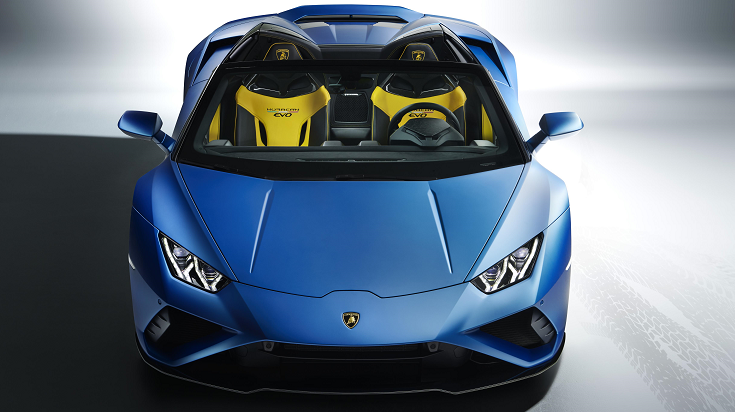
Stopping power is done via ventilated and cross-drilled steel brakes and covered by 19-inch Kari alloy wheels with specially-developed Pirelli P Zero tyres, with a 20-inch wheel available as an optional extra rims and carbon ceramic brakes.
Designed for life
The exterior features are characterized by a new front splitter and vertical fins within the larger, framed front air intakes. The rear bumper is coated in high gloss black while also incorporating a new diffuser unique to the supercar.
It’s soft-top roof stows within 17-seconds even while driving up to a speed of 50km/h. With soft top both up and down the driver can also electronically open the rear window, which functions as a windshield when up and highlights the engine’s unique sound when down.

An HMI 8.4-inch touchscreen in the find itself in the centre console, controlling the car’s functions as well as providing comprehensive connectivity for telephone calls, internet access and Apple CarPlay.
The Huracán is a driver’s car and a lifestyle choice, complemented by virtually limitless colour and trim options through Lamborghini Ad Personam, allowing owners to personalize their car to their exacting tastes.
]]>The colour combinations are black and gold; red, white and gold; blue, red and silver; and blue and white. The black and gold references the livery of the Lotus Type 72D which Emerson Fittipaldi raced to five victories over the course of the 1972 Formula 1 season.
Inspired by the greats
Red, white and gold echoes the Type 49B that Graham Hill raced in 1968, while the blue, red and silver is inspired by the Lotus Type 81 of 1980 driven by Nigel Mansell, Elio de Angelis and Mario Andretti.
The fourth new Elise, finished in blue and white, is in tribute to the Lotus Type 18 design from 1960. Exactly 60 years ago, it was the first Lotus car to achieve a Formula 1 pole position and victory, courtesy of the late Sir Stirling Moss, at the Monaco Grand Prix.
Officially called the Elise Classic Heritage Editions, all four offer an enhanced exterior and interior spec over the Elise Sport 220 on which they’re based.
Each car comes with an exclusive numbered ‘build plaque’ on the dashboard referencing the limited production run. A total of just 100 cars will be made, with the final numbers of each variant dictated by customer demand.
Each car has as standard a number of features which were previously on the options list. They include a DAB digital radio with four speakers, air-conditioning, cruise control, ultra-lightweight forged alloy wheels with racing livery finish, two-piece disc brakes and black carpet with floor mats.
The interior colour pack is also now integrated as standard. Elements include the upper door trim and central seat insert finished to match the exterior, with detailing on the door, gear selector surround and dashboard picking out key colours. The only one that’s different is the blue and white car, which has red alcantara seat centres.
Several optional extras are available for each car, including a fibreglass hardtop roof, lightweight lithium-ion battery and titanium lightweight exhaust.
]]>The videos, which were shot in Arjeplog, Sweden, show Hyundai WRC driver Thierry Neuville putting the i20 WRC, the RM19, and the i20 N through their paces in a snowy landscape. In addition, first images of the all-new i20 N have been released.
Performance goodness
The first video shows the i20 WRC rally car departing from a vehicle transporter and driving through darkened roads in Lapland, bonnet-mounted headlamps lighting its way.
As dawn breaks, it picks up speed, driving through snow-covered forests and around hairpin curves to reach its real playground: a frozen lake. The only sound is the revving of the engine as the car tears across the tundra on a bright Arctic day.
The video cuts to the RM19, skidding sideways along the road and leaving a plume of snow in its wake. In an interior shot, the viewer sees Neuville pumping the pedals and expertly maneuvering the prototype known as Hyundai’s ‘rolling lab’. The car draws sweeping curves across the snow.
The camera cuts again, and this time we see a prototype of the all-new i20 N, with camouflage covering over its front and rear. The viewer gets just partial glimpses of the new model’s details, as it drives across the snow.
Delving deeper
In the second video, which includes additional scenes of the all-new i20 N prototype, Neuville provides commentary to the footage, describing what it’s like to drive each model and outlining the unique characteristics of each car from his perspective. Neuville tested the all-new i20 N prototype by driving it alternating with the i20 WRC and RM19.
On the prototype all-new i20 N, Neuville said: “Very interesting car. Very precise. Very easy handling. The engine is revving nicely and the noise is very interesting as well. I’m looking forward to get this one to drive in WRC!”
Of the i20 WRC, Neuville says: ‘The WRC cars really push to the extreme. And every detail is fine tuned to get the maximum performance and also to be adapted to a driving style.”
He describes the RM19 as ‘very easy to drive.’ Speaking of the test drive, he says ‘I had a big smile on my face because I was driving sideways quite a lot.’
]]>The German brand already has an influx of different Mk7 performance variants like the GTI, Clubsport, Clubsport S, R and now the TCR. With the eighth-generation Golf, GTI and R models due to arrive in South Africa later this year, is the introduction of the TCR so close to the MK8 a wise move?
Weighing up options
Volkswagen had to introduce the TCR at some point before the MK8 Golf, because, well, 7 is before 8. With such a fragile economy and a dip in new car sales in recent months, the assumption would be that not many people would want to part with R669 000 at present if they’re unsure their jobs aren’t secured.
Majority of GTI afficionados already had their sights set on the MK8 GTI merely because the MK7 is ceasing production of all models. The introduction of the TCR and the fact that there will only be 297 units available, will definitely make people think twice. To sweeten the deal even further, each TCR will have a unique number that will be placed under the rear GTI logo as well as an ownership certificate.
Although pricing for the MK8 Golf range hasn’t been released yet, you can put it in the ballpark of R350 000, with the GTI at coming it over R500 000, roughly in the price range as those models currently on offer. Of course, petrolheads don’t care much for Trend and Comfortline trims, the GTI and R is what ticks the boxes.
Is it 7 or 8?
There is every chance that VW will sell most, if not all of the TCR models being shipped here. In addition, it is significantly cheaper than all of its competitors – the Hyundai I30 N and Honda Civic Type R for example – which makes it a standout option.
The MK8 on the other hand is an entirely different model altogether with different technologies and design. Furthermore, new VW models tend to do very well – as seen with the T-Cross and countless Polo’s.
From a logical point of view the new Golf is the best value-for-money option. Buying a model close to its expiration comes across as more of a compulsive buy, but you can argue that the TCR is not your average hatch and deserves the run its getting from now until the next-gen GTI arrives.
]]>Ford’s ‘Whisper Strategy’ delivers lots of small noise improvements around the vehicle that add up to a big difference, helping make journeys more comfortable and less tiring for drivers and passengers.
The sound of silence
For the new Kuga, Ford examined noise‑generating elements from the suspension to the door seals to help find ways to optimise interior refinement.
Adding perforations to Kuga Vignale leather seat bolsters reduced the total area of flat surfaces inside the cabin, helping absorb rather than reflect noise.
Aerodynamically-tuned sound shields are added underneath the body of the vehicle that help limit road and wind noise entering from outside.
READ | Ford EcoSport now boasts new automatic gearbox
Ford engineers spent two years testing more than 70 different tyres over surfaces from smooth Tarmac to rough concrete and cobbles, in wet and dry conditions and at a range of speeds to find the exact specification that kept road noise to a minimum while still delivering high levels of comfort and grip.
Channels behind the exterior panels that allow hidden wiring and components to pass from one area to another are smaller and narrower to limit airflow inside the body.
Refined quality
The ability to drive without a petrol or diesel engine enables quieter journeys. The plug-In Hybrid combines a petrol engine, electric motor and generator, and 14.4 kWh lithium-ion battery for zero-emission pure-electric driving capability.
Using the EV Now selectable drive mode switches off the petrol engine and powers the vehicle using battery and electric motor alone, achieving interior road noise levels of just 52 dB(A) in controlled tests – equivalent to gentle rainfall.
It also features Active Noise Cancellation technology. The system works just like popular noise-cancelling headphones – detecting unwanted low-frequency cabin sounds through strategically-placed microphones and counteracting them with an opposing soundwave from the B&O Sound System.
Telling sounds
A test carried out by Ford showed that occupants in the Kuga, experience interior noise levels that are just one quarter of those experienced by their grandparents in a 1966 Ford Anglia.
Below is comparative test, conducted in 3rd gear at a speed of 50km/h:
| Vehicle | Max decibels dB(A) |
| 1966 Ford Anglia | 89 (89.4) |
| 1970 Ford Cortina | 81 (80.9) |
| 1977 Ford Granada | 83 (82.5) |
| 1982 Ford Cortina | 79 (78.5) |
| 2000 Ford Mondeo | 77 (77.3) |
| 2020 Ford Kuga Plug-In Hybrid | 69 (69.3) |
Toyota, one of the biggest automakers in the world, had the Supra in its line-up up until the turn of the millennium, but primary objectives forced the carmaker’s hand to halt production on it. Various factors played a role in that decision and so closed the final curtain. Only thing is, it wasn’t the final curtain because the Supra returned with a vengeance.
A major factor that made the Supra’s return possible was Toyota’s partnership with BMW. Or part-sharing agreement, if you will. The agreement allows Toyota to use the BMW Z4’s underpinnings as the basis for its Supra, but also that the Supra borrows an interior from BMW. Does this mean that the Supra is a rebadged Z4? It sure would come across as such, but fortunately, it’s not.
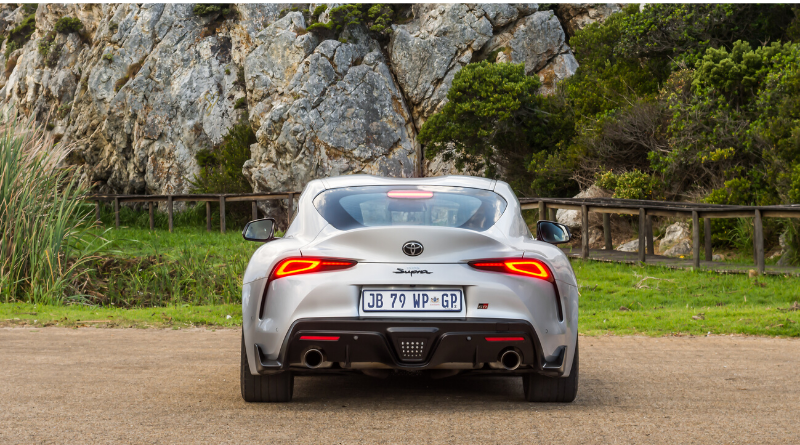
BMW interior? What?!
Toyota has been producing beautiful and practical interiors of late – think Corolla. But on the 2019 Supra, it’s not the case. The Japanese automaker borrowed more from BMW than just the engine. The dashboard, complete with dials and buttons, is BMW’s previous-generation interior. Even the buttons on the steering are BMW’s.
Other interior bits worth noting is the access area behind the seats. This allows easy access to the cargo area, but, admittedly, the hole is rather big. You almost get the sense that there should’ve been a divider; even if it is just for aesthetic purposes. Regardless, the interior does exude a sense of sportiness and from the get-go, the driver is rearing to go.
The Supra’s interior may come from Germany, but it does nothing to make the car feel like an inferior product.
READ: It’s back! Toyota Supra returns to SA!
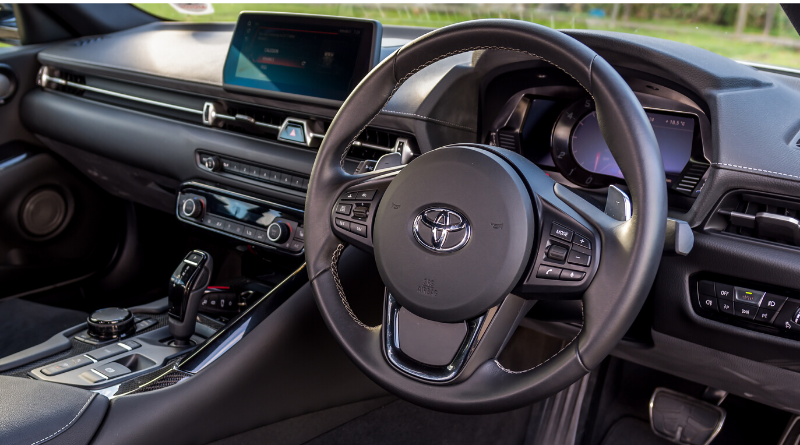
What about the engine?
In the generations preceding this fifth-generation Supra, a six-cylinder 3.0-litre petrol engine powered this Japanese sports car. The problem Toyota has now is that it does not have such an engine in its line-up to use in the Supra. And to produce one would cost millions and having it comply with emission standards… It’s a task that’ll be an unnecessary expense. Unnecessary in the sense that why research when someone else already did?
Enter BMW.
BMW builds some of the world’s best 3.0-litre six-cylinder engines and was it a natural decision for Toyota to partner with BMW. Looking across the pond, Jaguar, Mercedes-Benz, and Audi all produce six-cylinder motors, but none more renowned and reputable than BMW. The Supra shares its engine, gearbox, and chassis with the BMW Z4. In terms of the engine, the unit delivers an impressive 250kW and 500Nm. An eight-speed automatic gearbox sends power to the rear wheels, which gifts the car a nicely balanced drive.
BMW may have supplied the Supra’s heart and organs, but the personality is all on Toyota.
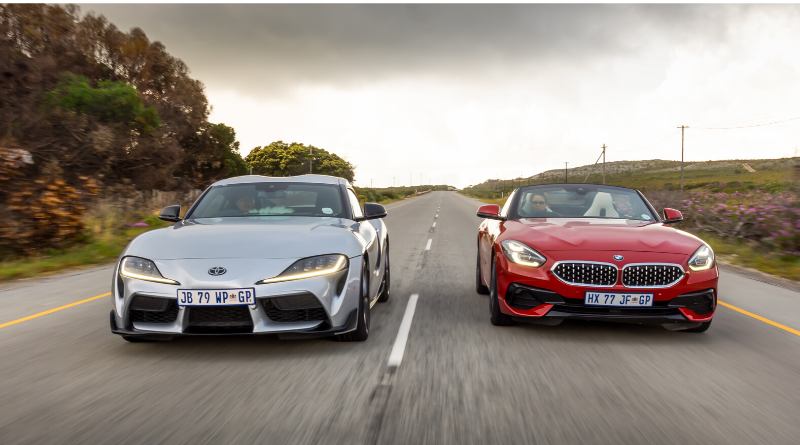
Give me more!
Deactivate DSC (Dynamic Stability Control), flick the drive mode to Sport, stamp on the brakes, feed some fuel into the engine, and wait for Launch Control to engage. Once engaged, release brakes and allow the car to hurtle towards the horizon. What a sensation! Damn, this is pretty epic! The engine roars towards the redline, slap the paddles behind the steering wheel to engage the next gear and listen to the exhaust bark.
Every gear is hooked with a menacing grip that forces you to grip the steering wheel tightly; yet with a gentleness. It’s an enticing experience that warrants successive attempts at chasing the thrill.
The Supra not only excels in a straight line. As soon as you find the car’s groove, it dances through all of your favourite bends. Sweeping bends, hard-braking ones… it all plays into the Supra’s hands. This isn’t a BMW Z4 with a hard-top roof. This is a Toyota Supra; a sports car in its own right.
The Supra needs only 4.3 seconds to go from standstill to 100km/h, and top speed is a claimed 250km/h.
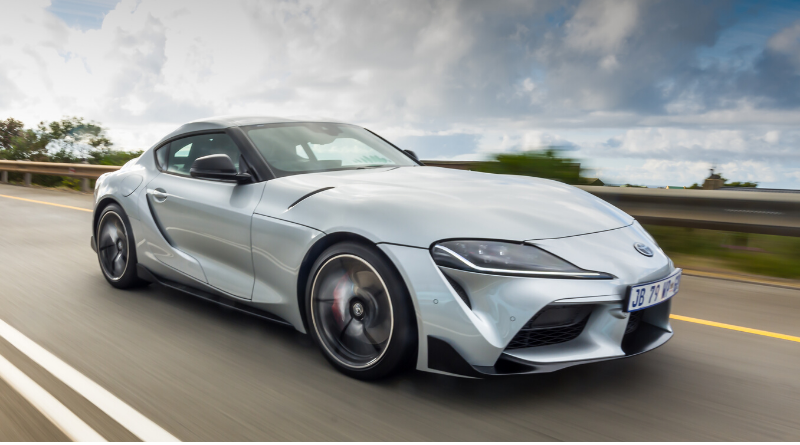
Summary
While Toyota may face some criticism for joining forces with BMW, it was a smart move on the Japanese automaker’s part. The agreement allows Toyota to tap into BMW’s technical know-how, which has a direct impact as to how its Supra carries itself on the road. In all, the 2019 Toyota Supra is a sports car that can hold its own in its segment.
I’ll admit, the interior is a bit of an overkill in terms of the part-sharing, but one can overlook it when you view the car as a whole. And when you judge the car as a whole, you can’t help but agree that this has to be one of 2019’s greatest highlights.
Price: R1 072 300
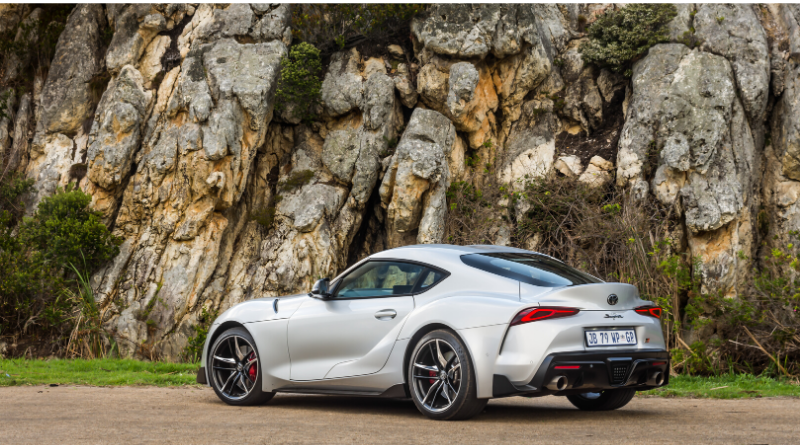
Not only is the Ferrari Roma an icon of Italian design, but it also represents the pinnacle of performance in this category, thanks to its turbocharged V8 from the family of engines that have won the overall International Engine of the Year award four years running. In this version, the engine reaches 456kW at 7500rpm and is coupled with the new eight-speed DCT gearbox that was introduced on the SF90 Stradale.
With its distinctive flair and style, the car is a contemporary representation of the carefree, pleasurable way of life that characterised Rome in the 1950s and ‘60s. The Ferrari Roma offers discerning clients the finesse and refinement that brings the concept of “la Dolce Vita” right up to date.
READ: Ferrari reveals new F8 Spider
Engine
- Type: Turbocharged V8
- Displacement: 3855cc
- Bore & stroke: 86.5mm x 82mm
- Power: 456kW
- Torque: 760Nm
Dimensions and weight
- Length: 4656mm
- Width: 1974mm
- Height: 1301mm
- Wheelbase: 2670mm
- Dry weight: 1472kg
Performance
- Top speed: >320km/h
- 0 – 100km/h: 3.4s
- 0 – 200km/h: 9.3s
The updated model comes standard with sport suspension, sport exhaust tailpipe fin, Smart (keyless) entry, push start button, rear parking sensors, automatic folding exterior mirrors, leather steering wheel & shift lever, Intelligent Around View Monitor, Moving Object Detection and blind-spot warning.
The 84kW Tekna model comes with LED headlights and front fog lights, automatic air conditioner, and automatic headlight leveler and the Tekna Plus, with ‘Invigorating Red’ interior personalisation, leather heated seats and ‘Enigma Black’ exterior colour.
Improved all-round
In addition to the 84kW, the turbocharged 1.0-litre petrol engine also produces 180Nm. The new DIG-T (Direct Injection Gasoline – Turbo) engine features a number of technical innovations that allow it to deliver a spirited performance while maintaining high fuel economy and low CO2 emissions, says Nissan.
Nissan further claims that the car offers a better driving experience than before and boasts improved stability as well as tighter handling, with a six-speed manual transmission, and a dropped suspension that turns heads wherever the new Nissan Micra goes.
The flagship versions featuring the 1.0-litre engine have a ride height that’s around 10mm lower and a revised suspension tuning to optimise the benefits of that reduction.
The all-new Nissan Micra 84 kW will be on sale in dealerships from November 2019 onwards, joining the existing 66 kW version.
REVIEW: Nissan Micra Acenta hits high notes
Pricing:
- Micra 66kW Turbo Visia: R252 800
- Micra 66kW Turbo Acenta: R279 400
- Micra 66kW Turbo Acenta Plus: R295 400
- Micra 84kW Turbo Acenta Plus: R305 900
- Micra 84kW Turbo Tekna: R326 300
- Micra 84kW Turbo Tekna Plus: R336 900
Built on an all-new platform with bigger dimensions than its predecessor, Hyundai says the spacious cabin and improved ride and handling with low NVH (noise, vibration and harshness) levels, should see the Atos be at the top of buyers in the entry-level car segment the shopping list.
The new Atos hatchback, which will slot into the local Hyundai range below the Grand i10, is also equipped with a four-cylinder engine that is said to be fuel-efficient, which is an important criterium on the list of consumers who shop around in this segment of the car market.
Under 6.0 L/100km
The re-entry of Atos in South Africa followed road tests over a 1 100km route that ranged from sea-level to the high altitude of the Highveld – all done in on-the-road comparison with some of the new model’s main rivals in its segment.
The 50kW maximum power that the Atos’ 1 086cc engine delivers at 5 500 revolutions per minute, as well as the maximum torque of 99Nm which comes at 2 800r/min., compares very favourably with a range of competitors in its market segment, says Hyundai. Official fuel consumption, tested in a real-world combined cycle, is 5.7 L/100km.
Its dimensions and ground clearance are also on par with its rivals, but it is the whole package with a complete list of features that the Atos offers at a most competitive price which will perk the interest of new car buyers.
The list of standard features includes:
- An infotainment system with a seven-inch touch screen and Apple Carplay and Bluetooth connectivity;
- An onboard computer;
- A multifunction steering with remote buttons for the radio, sound system, and Bluetooth-connected cell phone;
- A dedicated USB charging socket that also serves as a connection point for Apple’s Carplay, as well as an extra 12V power socket;
- An air conditioner;
- Electrically controlled front side windows;
- Stylish, comfortable seats with durable cover materials;
- Airbags for the driver and front passenger;
- ABS to keep control under emergency braking, especially on a wet road; and
- ISOFIX child seat attachment points on the rear seat bench.
Included in the Atos’ asking price of R159 900 is a seven-year/200 000km warranty, a one-year service plan, and roadside assistance for seven years or 150 000km. Services are done at 15 000km (or annually). The Atos is offered in colours ranging from the eye-catching and spritely Acid Yellow to Polar White, Titan Grey, Fiery Red, Alpha Blue, and Typhoon Silver.